Jingkuan Song
Explore Briefly, Then Decide: Mitigating LLM Overthinking via Cumulative Entropy Regulation
Oct 02, 2025Abstract:Large Language Models (LLMs) have demonstrated remarkable reasoning abilities on complex problems using long Chain-of-Thought (CoT) reasoning. However, they often suffer from overthinking, meaning generating unnecessarily lengthy reasoning steps for simpler problems. This issue may degrade the efficiency of the models and make them difficult to adapt the reasoning depth to the complexity of problems. To address this, we introduce a novel metric Token Entropy Cumulative Average (TECA), which measures the extent of exploration throughout the reasoning process. We further propose a novel reasoning paradigm -- Explore Briefly, Then Decide -- with an associated Cumulative Entropy Regulation (CER) mechanism. This paradigm leverages TECA to help the model dynamically determine the optimal point to conclude its thought process and provide a final answer, thus achieving efficient reasoning. Experimental results across diverse mathematical benchmarks show that our approach substantially mitigates overthinking without sacrificing problem-solving ability. With our thinking paradigm, the average response length decreases by up to 71% on simpler datasets, demonstrating the effectiveness of our method in creating a more efficient and adaptive reasoning process.
More Than One Teacher: Adaptive Multi-Guidance Policy Optimization for Diverse Exploration
Oct 02, 2025Abstract:Reinforcement Learning with Verifiable Rewards (RLVR) is a promising paradigm for enhancing the reasoning ability in Large Language Models (LLMs). However, prevailing methods primarily rely on self-exploration or a single off-policy teacher to elicit long chain-of-thought (LongCoT) reasoning, which may introduce intrinsic model biases and restrict exploration, ultimately limiting reasoning diversity and performance. Drawing inspiration from multi-teacher strategies in knowledge distillation, we introduce Adaptive Multi-Guidance Policy Optimization (AMPO), a novel framework that adaptively leverages guidance from multiple proficient teacher models, but only when the on-policy model fails to generate correct solutions. This "guidance-on-demand" approach expands exploration while preserving the value of self-discovery. Moreover, AMPO incorporates a comprehension-based selection mechanism, prompting the student to learn from the reasoning paths that it is most likely to comprehend, thus balancing broad exploration with effective exploitation. Extensive experiments show AMPO substantially outperforms a strong baseline (GRPO), with a 4.3% improvement on mathematical reasoning tasks and 12.2% on out-of-distribution tasks, while significantly boosting Pass@k performance and enabling more diverse exploration. Notably, using four peer-sized teachers, our method achieves comparable results to approaches that leverage a single, more powerful teacher (e.g., DeepSeek-R1) with more data. These results demonstrate a more efficient and scalable path to superior reasoning and generalizability. Our code is available at https://github.com/SII-Enigma/AMPO.
Learning Generalizable and Efficient Image Watermarking via Hierarchical Two-Stage Optimization
Aug 12, 2025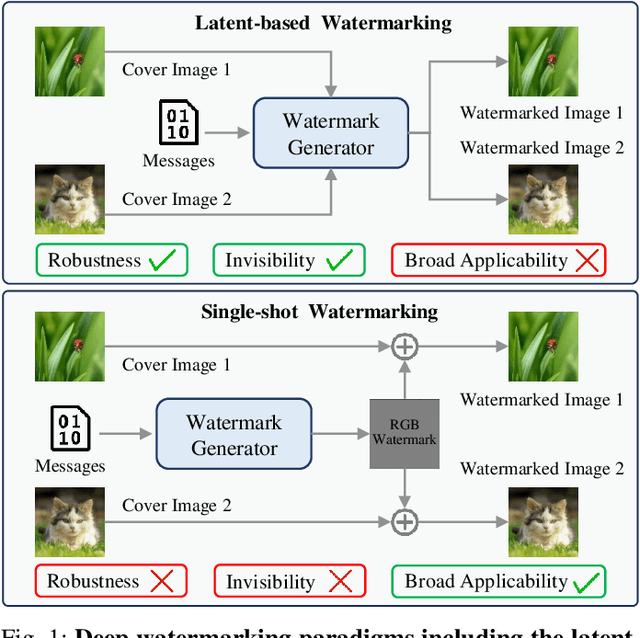
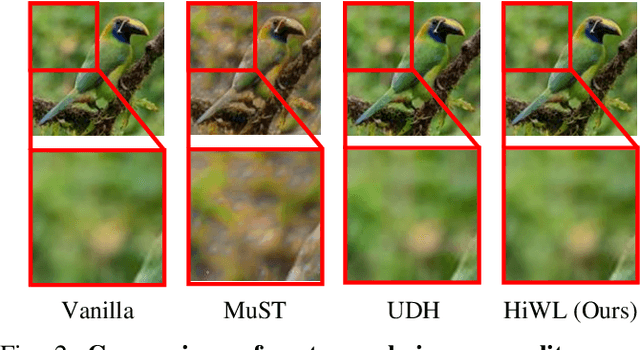
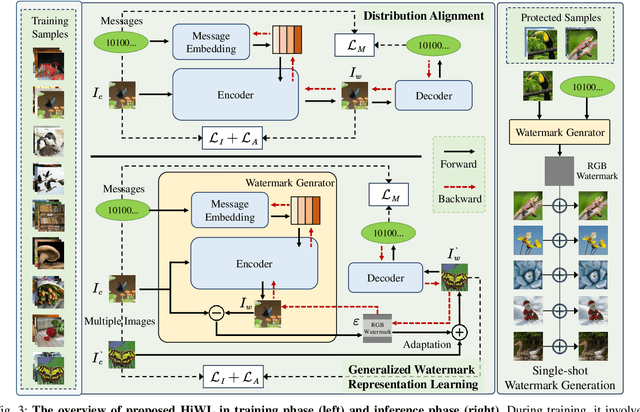
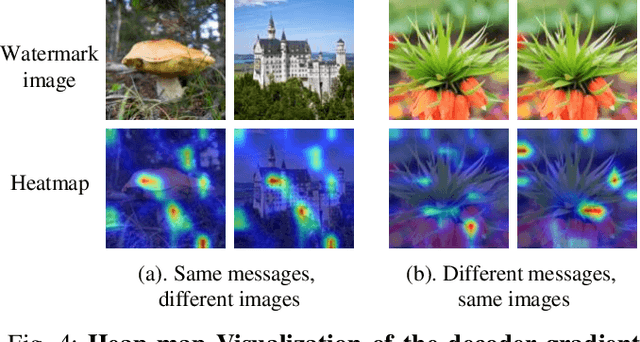
Abstract:Deep image watermarking, which refers to enable imperceptible watermark embedding and reliable extraction in cover images, has shown to be effective for copyright protection of image assets. However, existing methods face limitations in simultaneously satisfying three essential criteria for generalizable watermarking: 1) invisibility (imperceptible hide of watermarks), 2) robustness (reliable watermark recovery under diverse conditions), and 3) broad applicability (low latency in watermarking process). To address these limitations, we propose a Hierarchical Watermark Learning (HiWL), a two-stage optimization that enable a watermarking model to simultaneously achieve three criteria. In the first stage, distribution alignment learning is designed to establish a common latent space with two constraints: 1) visual consistency between watermarked and non-watermarked images, and 2) information invariance across watermark latent representations. In this way, multi-modal inputs including watermark message (binary codes) and cover images (RGB pixels) can be well represented, ensuring the invisibility of watermarks and robustness in watermarking process thereby. The second stage employs generalized watermark representation learning to establish a disentanglement policy for separating watermarks from image content in RGB space. In particular, it strongly penalizes substantial fluctuations in separated RGB watermarks corresponding to identical messages. Consequently, HiWL effectively learns generalizable latent-space watermark representations while maintaining broad applicability. Extensive experiments demonstrate the effectiveness of proposed method. In particular, it achieves 7.6\% higher accuracy in watermark extraction than existing methods, while maintaining extremely low latency (100K images processed in 8s).
Dynamic Pattern Alignment Learning for Pretraining Lightweight Human-Centric Vision Models
Aug 10, 2025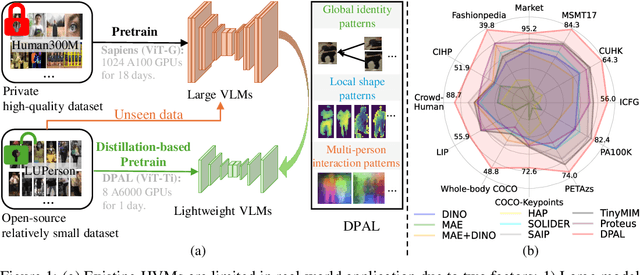
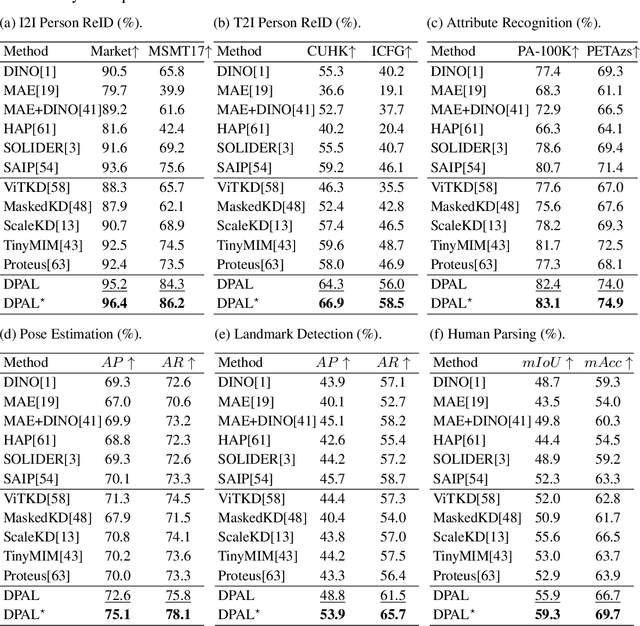
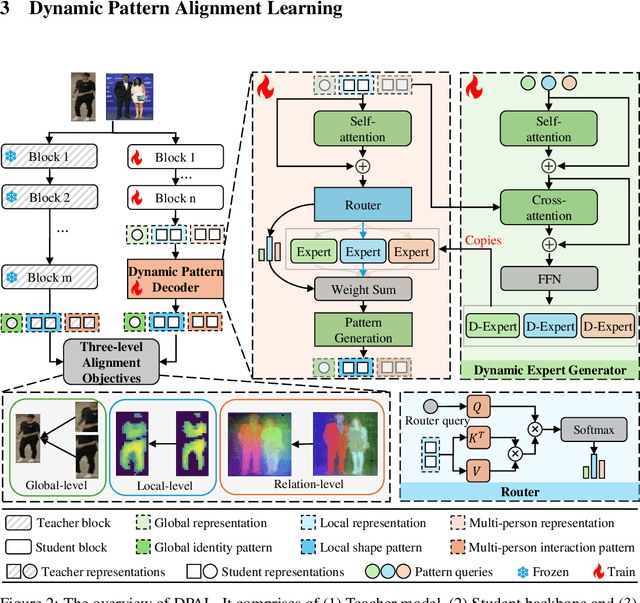
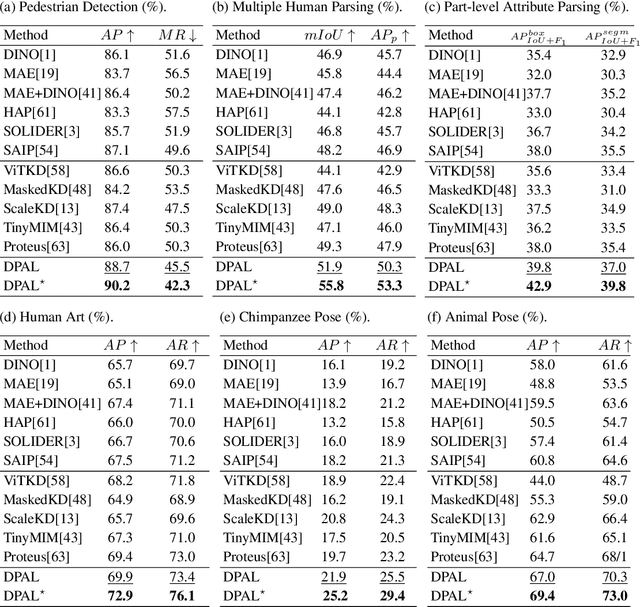
Abstract:Human-centric vision models (HVMs) have achieved remarkable generalization due to large-scale pretraining on massive person images. However, their dependence on large neural architectures and the restricted accessibility of pretraining data significantly limits their practicality in real-world applications. To address this limitation, we propose Dynamic Pattern Alignment Learning (DPAL), a novel distillation-based pretraining framework that efficiently trains lightweight HVMs to acquire strong generalization from large HVMs. In particular, human-centric visual perception are highly dependent on three typical visual patterns, including global identity pattern, local shape pattern and multi-person interaction pattern. To achieve generalizable lightweight HVMs, we firstly design a dynamic pattern decoder (D-PaDe), acting as a dynamic Mixture of Expert (MoE) model. It incorporates three specialized experts dedicated to adaptively extract typical visual patterns, conditioned on both input image and pattern queries. And then, we present three levels of alignment objectives, which aims to minimize generalization gap between lightweight HVMs and large HVMs at global image level, local pixel level, and instance relation level. With these two deliberate designs, the DPAL effectively guides lightweight model to learn all typical human visual patterns from large HVMs, which can generalize to various human-centric vision tasks. Extensive experiments conducted on 15 challenging datasets demonstrate the effectiveness of the DPAL. Remarkably, when employing PATH-B as the teacher, DPAL-ViT/Ti (5M parameters) achieves surprising generalizability similar to existing large HVMs such as PATH-B (84M) and Sapiens-L (307M), and outperforms previous distillation-based pretraining methods including Proteus-ViT/Ti (5M) and TinyMiM-ViT/Ti (5M) by a large margin.
Shortcut Learning in Generalist Robot Policies: The Role of Dataset Diversity and Fragmentation
Aug 08, 2025Abstract:Generalist robot policies trained on large-scale datasets such as Open X-Embodiment (OXE) demonstrate strong performance across a wide range of tasks. However, they often struggle to generalize beyond the distribution of their training data. In this paper, we investigate the underlying cause of this limited generalization capability. We identify shortcut learning -- the reliance on task-irrelevant features -- as a key impediment to generalization. Through comprehensive theoretical and empirical analysis, we uncover two primary contributors to shortcut learning: (1) limited diversity within individual sub-datasets, and (2) significant distributional disparities across sub-datasets, leading to dataset fragmentation. These issues arise from the inherent structure of large-scale datasets like OXE, which are typically composed of multiple sub-datasets collected independently across varied environments and embodiments. Our findings provide critical insights into dataset collection strategies that can reduce shortcut learning and enhance the generalization ability of generalist robot policies. Moreover, in scenarios where acquiring new large-scale data is impractical, we demonstrate that carefully selected robotic data augmentation strategies can effectively reduce shortcut learning in existing offline datasets, thereby improving generalization capabilities of generalist robot policies, e.g., $\pi_0$, in both simulation and real-world environments. More information at https://lucky-light-sun.github.io/proj/shortcut-learning-in-grps/.
SafePTR: Token-Level Jailbreak Defense in Multimodal LLMs via Prune-then-Restore Mechanism
Jul 02, 2025Abstract:By incorporating visual inputs, Multimodal Large Language Models (MLLMs) extend LLMs to support visual reasoning. However, this integration also introduces new vulnerabilities, making MLLMs susceptible to multimodal jailbreak attacks and hindering their safe deployment.Existing defense methods, including Image-to-Text Translation, Safe Prompting, and Multimodal Safety Tuning, attempt to address this by aligning multimodal inputs with LLMs' built-in safeguards.Yet, they fall short in uncovering root causes of multimodal vulnerabilities, particularly how harmful multimodal tokens trigger jailbreak in MLLMs? Consequently, they remain vulnerable to text-driven multimodal jailbreaks, often exhibiting overdefensive behaviors and imposing heavy training overhead.To bridge this gap, we present an comprehensive analysis of where, how and which harmful multimodal tokens bypass safeguards in MLLMs. Surprisingly, we find that less than 1% tokens in early-middle layers are responsible for inducing unsafe behaviors, highlighting the potential of precisely removing a small subset of harmful tokens, without requiring safety tuning, can still effectively improve safety against jailbreaks. Motivated by this, we propose Safe Prune-then-Restore (SafePTR), an training-free defense framework that selectively prunes harmful tokens at vulnerable layers while restoring benign features at subsequent layers.Without incurring additional computational overhead, SafePTR significantly enhances the safety of MLLMs while preserving efficiency. Extensive evaluations across three MLLMs and five benchmarks demonstrate SafePTR's state-of-the-art performance in mitigating jailbreak risks without compromising utility.
OmniCharacter: Towards Immersive Role-Playing Agents with Seamless Speech-Language Personality Interaction
May 26, 2025Abstract:Role-Playing Agents (RPAs), benefiting from large language models, is an emerging interactive AI system that simulates roles or characters with diverse personalities. However, existing methods primarily focus on mimicking dialogues among roles in textual form, neglecting the role's voice traits (e.g., voice style and emotions) as playing a crucial effect in interaction, which tends to be more immersive experiences in realistic scenarios. Towards this goal, we propose OmniCharacter, a first seamless speech-language personality interaction model to achieve immersive RPAs with low latency. Specifically, OmniCharacter enables agents to consistently exhibit role-specific personality traits and vocal traits throughout the interaction, enabling a mixture of speech and language responses. To align the model with speech-language scenarios, we construct a dataset named OmniCharacter-10K, which involves more distinctive characters (20), richly contextualized multi-round dialogue (10K), and dynamic speech response (135K). Experimental results showcase that our method yields better responses in terms of both content and style compared to existing RPAs and mainstream speech-language models, with a response latency as low as 289ms. Code and dataset are available at https://github.com/AlibabaResearch/DAMO-ConvAI/tree/main/OmniCharacter.
Unlocking Smarter Device Control: Foresighted Planning with a World Model-Driven Code Execution Approach
May 22, 2025Abstract:The automatic control of mobile devices is essential for efficiently performing complex tasks that involve multiple sequential steps. However, these tasks pose significant challenges due to the limited environmental information available at each step, primarily through visual observations. As a result, current approaches, which typically rely on reactive policies, focus solely on immediate observations and often lead to suboptimal decision-making. To address this problem, we propose \textbf{Foresighted Planning with World Model-Driven Code Execution (FPWC)},a framework that prioritizes natural language understanding and structured reasoning to enhance the agent's global understanding of the environment by developing a task-oriented, refinable \emph{world model} at the outset of the task. Foresighted actions are subsequently generated through iterative planning within this world model, executed in the form of executable code. Extensive experiments conducted in simulated environments and on real mobile devices demonstrate that our method outperforms previous approaches, particularly achieving a 44.4\% relative improvement in task success rate compared to the state-of-the-art in the simulated environment. Code and demo are provided in the supplementary material.
InSpire: Vision-Language-Action Models with Intrinsic Spatial Reasoning
May 20, 2025Abstract:Leveraging pretrained Vision-Language Models (VLMs) to map language instruction and visual observations to raw low-level actions, Vision-Language-Action models (VLAs) hold great promise for achieving general-purpose robotic systems. Despite their advancements, existing VLAs tend to spuriously correlate task-irrelevant visual features with actions, limiting their generalization capacity beyond the training data. To tackle this challenge, we propose Intrinsic Spatial Reasoning (InSpire), a simple yet effective approach that mitigates the adverse effects of spurious correlations by boosting the spatial reasoning ability of VLAs. Specifically, InSpire redirects the VLA's attention to task-relevant factors by prepending the question "In which direction is the [object] relative to the robot?" to the language instruction and aligning the answer "right/left/up/down/front/back/grasped" and predicted actions with the ground-truth. Notably, InSpire can be used as a plugin to enhance existing autoregressive VLAs, requiring no extra training data or interaction with other large models. Extensive experimental results in both simulation and real-world environments demonstrate the effectiveness and flexibility of our approach. Our code, pretrained models and demos are publicly available at: https://Koorye.github.io/proj/Inspire.
Policy Contrastive Decoding for Robotic Foundation Models
May 19, 2025Abstract:Robotic foundation models, or generalist robot policies, hold immense potential to enable flexible, general-purpose and dexterous robotic systems. Despite their advancements, our empirical experiments reveal that existing robot policies are prone to learning spurious correlations from pre-training trajectories, adversely affecting their generalization capabilities beyond the training data. To tackle this, we propose a novel Policy Contrastive Decoding (PCD) approach, which redirects the robot policy's focus toward object-relevant visual clues by contrasting action probability distributions derived from original and object-masked visual inputs. As a training-free method, our PCD can be used as a plugin to improve different types of robot policies without needing to finetune or access model weights. We conduct extensive experiments on top of three open-source robot policies, including the autoregressive policy OpenVLA and the diffusion-based policies Octo and $\pi_0$. The obtained results in both simulation and real-world environments prove PCD's flexibility and effectiveness, e.g., PCD enhances the state-of-the-art policy $\pi_0$ by 8% in the simulation environment and by 108% in the real-world environment. Code and demos are publicly available at: https://Koorye.github.io/proj/PCD.
 Add to Chrome
Add to Chrome Add to Firefox
Add to Firefox Add to Edge
Add to Edge